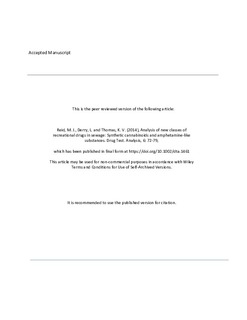| dc.description.abstract | The analysis of sewage for the residues of commonly used illicit drugs has successfully been applied as a suitable approach for estimating community illicit drug use. The drug market is increasingly dynamic with new substances continually being marketed for recreational purposes. In this study, ultra‐high pressure liquid chromatography coupled to tandem mass spectrometry (UHPLC‐MS/MS) was used to simultaneously and quantitatively detect the exogenous biomarkers of new classes of recreational drugs in sewage collected from three different Norwegian cities (Oslo, Bergen, Hamar). The samples were screened for the presence of khat (d‐norpseudoephedrine and cathinone), mephedrone, pseudoephedrine, 7‐aminoflunitrazepam, para‐methoxyamphetamine (PMA), para‐methoxy‐N‐methylamphetamine (PMMA) and a selection of urinary metabolites of synthetic cannabinoids collectively termed ´Spice´ (5‐3‐1‐naphthoyl‐1H‐indol‐1‐yl‐pentanoic acid (JWH 018 N‐pentanoic acid), 1‐5‐hydroxypentyl‐1H‐indol‐3‐ylnaphthalen‐1‐yl‐methanone (JWH 018 N‐5‐hydroxypentyl), 4‐3‐1‐naphthoyl‐1H‐indol‐1‐yl‐butanoic acid (JWH 073 N‐butanoic acid), 1‐4‐hydroxybutyl‐1H‐indol‐3‐ylnaphthalen‐1‐yl‐methanone (JWH 073 N‐4‐hydroxybutyl), 1‐5‐hydroxypentyl‐1H‐indol‐3‐yl4‐methylnaphthalen‐1‐yl‐methanone (JWH 122 N‐5‐hydroxypentyl), 1‐5‐fluoro‐4‐hydroxypentyl‐1H‐indol‐3‐ylnaphthalen‐1‐ylmethanone (AM2201 N‐4‐hydroxypentyl), and 1‐5‐hydroxypentyl‐1H‐indol‐3‐yl4‐methoxyphenyl‐methanone (RCS‐4 N‐5‐hydroxypentyl)). Limits of detection were 1 ng/L for amphetamine like compounds and 5 ng/L for the metabolites of synthetic cannabinoids while the limits of quantification were 3 and 15 ng/L, respectively. Three of the fourteen selected biomarkers (cathine, pseudoephedrine and the synthetic cannabinoid metabolite JWH‐018 N‐5‐hydroxypentyl) were detected in sewage, alongside the illicit drugs (and/or metabolites) typically found in sewage (cocaine, benzoylecognine, methamphetamine, MDMA, and THC‐COOH). The khat biomarker d‐norpseudoephedrine was detected in Oslo sewage at a mean concentration of 93 ng/L that represents a daily load of 54 mg/day/1000 inhabitants. Pseudoephedrine was present at mean concentrations of between 27 and 67 ng/L representing normalized daily loads of between 10 (Hamar) and 24 mg/day/1000 inhabitants (Bergen). The daily normalized loads of JWH‐018 N‐5‐hydroxypentyl were between 49 (Oslo) and 62 mg/day/1000 inhabitants (Hamar). This study demonstrates for the first time that sewage biomarker analysis can be applied to evaluate not only the use the traditional illicit drugs (cocaine, cannabis and amphetamines), but also the use of certain new synthetic drugs. | nb_NO |
